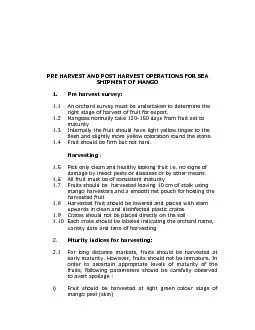/


1 Pre harvest survey 11 An orchard survey must be undertaken to determine the 12 Mangoes normally take 120150 days from fruit set to 13 Internally the fruit should have light yellow tinges t ID: 100791
Download Pdf The PPT/PDF document "PRE HARVEST AND POST HARVEST OPERATIONS ..." is the property of its rightful owner. Permission is granted to download and print the materials on this web site for personal, non-commercial use only, and to display it on your personal computer provided you do not modify the materials and that you retain all copyright notices contained in the materials. By downloading content from our website, you accept the terms of this agreement.
PRE HARVEST AND POST HARVEST OPERATIONS FOR SEA SHIPMENT OF MANGO 1. Pre harvest survey: 1.1 An orchard survey must be undertaken to determine the 1.2 Mangoes normally take 120-150 days from fruit set to 1.3 Internally the fruit should have light yellow tinges to the 1.4 Fruit should be firm but not hard. Harvesting : 1.5 Pick only clean and healthy looking fruit i.e. no signs of 1.6 All fruit must be of consistent maturity 1.7 Fruits should be harvested leaving 10 cm of stalk using 1.8 Harvested fruit should be lowered and placed with stem 1.9 Crates should not be placed directly on the soil 1.10 Each crate should be labeled indicating the orchard name, 2. Mturity indices for harvesting: 2.1 For long distance markets, fr i) Fruit should be harvested at ii) Fruit should be harvested with iii) Total soluble solids (TSS) of iv) Fruit acidity recommended : pH 4.0 v) The fruits of uniform char vi) Consignment lot should compri Harvesting should be planned keeping in view the above factors. field heat in the fruits. 4. Method of harvesting : 4.1 For harvesting of the frui 4.2 It is recommended that afte 5. Transportation to the packhouse : 5.1 The fruits should be quickl to packhouse. Efforts should be made to pack the fruits in the nearest packhouse to minimize the delay and to avoid damage to the fruit during transit. 6. Post Harvest Process : 6.1 De-sapping (Optional): (a) Desapping is a process of removing the sap from (b) The sap from the fruit (c) At the time of stalk cuttiupside down so as to avoi (d) It is advisable that whol (e) This process should (f) It would be appropriate 6.2 Cleaning and washing of fruit : (a) After de-sapping, the fruits should be washed (b) It is recommended that 6.3 Hot-Water Treatment (Mandatory for USA): (a) After de-sapping and washing, mango fruits should be passed through hot water treatment tanks fitted with to maintain the desired temperature of 52 0 C. The hot water should be treated with disinfectant such as sodium hypochlorite/procloraz (b) After hot water treatmen 6.4 Sorting and Grading : Over-sized/under-sized /blemished /diseased/damaged fruits shall be removed at sorting table. Though maturity indices are observed at harvesteing stage as mentioned at The fruits falling in uniform criteria shall be graded and packaged accordingly. Fruits should be handled carefully and placed gently into the packing boxes to avoid bruising/injury. Fruits shall be graded as per size,weight, shape and colour or as per the market requirements. The grading shall also be done by following the grade requirements as notified by Directorate of Marketing and Inspection, Government of India. 7. Pre-cooling : Immediately after packing, the packed fruits shall be transferred to pre cooling chamber . The recommended temperature of pre cooling chamber is 12-13 0 C. 8. Packaging and palletization : 8.1 It is advisable that packag 8.2 Fruits shall be placed into 8.3 Mango fruits should be packed in single layer within the 2. 8.4 The packing material should 8.5 Adequate ventilation (opening 8.6 Packing material of only f 8.7 Carton labelling shall be do 8.8 After packaging, palletization 8.9 The pallets should be secured 8.10 Stacked packages shall be immediately loaded into the 0 C with a relative humidity of 90-95% 9. Container loading : 9.1 Process of shipping shall be 9.2 Before loading the consignment, temperature of the fruit 0 C. 9.3 Temperature of the loading ba 0 C. 9.4 Air flow movement should be provided by stacking the 9.5 The temperature of the contai 0 C. 9.6 The Relative Humidity (RH) should be 90-95%. 10. In-Transit processes : 10.1 The temprature during tr 10.2 The temperature of 12 0 C shall be maintained throughout the transit period 10.3 It would always be advisabl 10.4 To avoid the breaking of 0 C.) till fruits are supplied to the market. PRECAUTIONARY NOTES : 1. Avoid the incidence of disease development by applying management measures at the earliest 2. Avoid complete or advance stage of maturity of fruit 3. Avoid the retention of field heat for longer durations 4. Avoid the delays in entering the cool chain 5. Avoid breakage of cool chain 6. Avoid temperature fluctuation 7. Avoid sending damaged fruits or fruits with black spots , sap coated or insect damages : FOR SHIPMENT OF MANGOES TO USA , IT IS MANDATORY TO GET THE CONSIGNMENT IRRADIATED AT AN APPROVED FACILITY . CURRENTLY , KRUSHAK AT LASALGAON IS THE ONLY APOPROVED : FOR SHIPMENT OF MANGOES TO JAPAN, IT IS MANDATORY TO GET THE CONSIGNMENT VAPOUR HEAT TREATED , CURRENTLY THE APPROVED FACILITIES FOR VAPOUR HEAT TREATMENT (VHT) EXIST AT MSAMB, VASHI, MAHARASHTRA; AP STATE AGRO INDUSTRIES DEVELOPMENT CORPORATION AT TIRUPATHI AND NUZVID, A.P.; UP MANDI PARISHAD, SAHARANPUR, UP AND GALLA FOODS LIMITED, CHITTOOR , AP, NIKKO NAMDHARI SEAPROTOCOL/APEDA/FEBRUARY2009